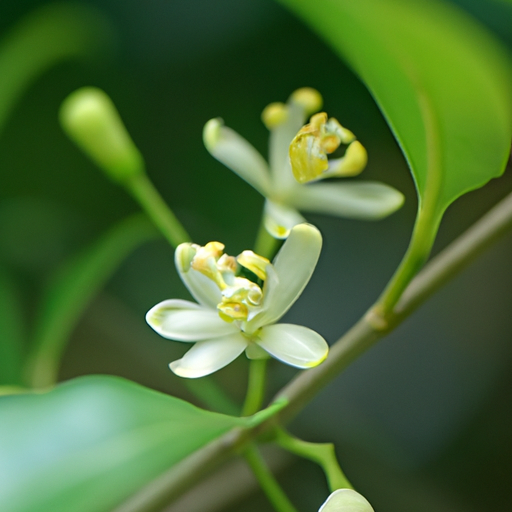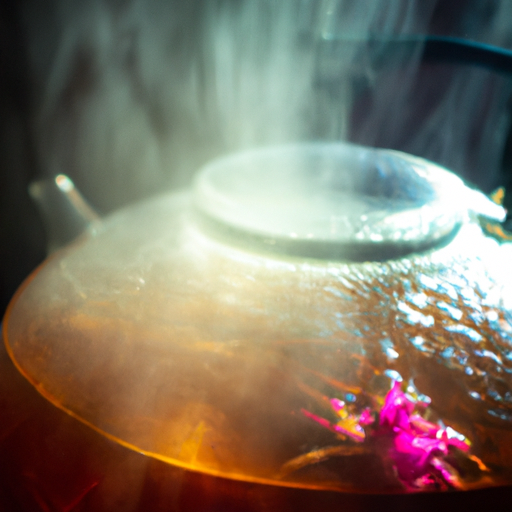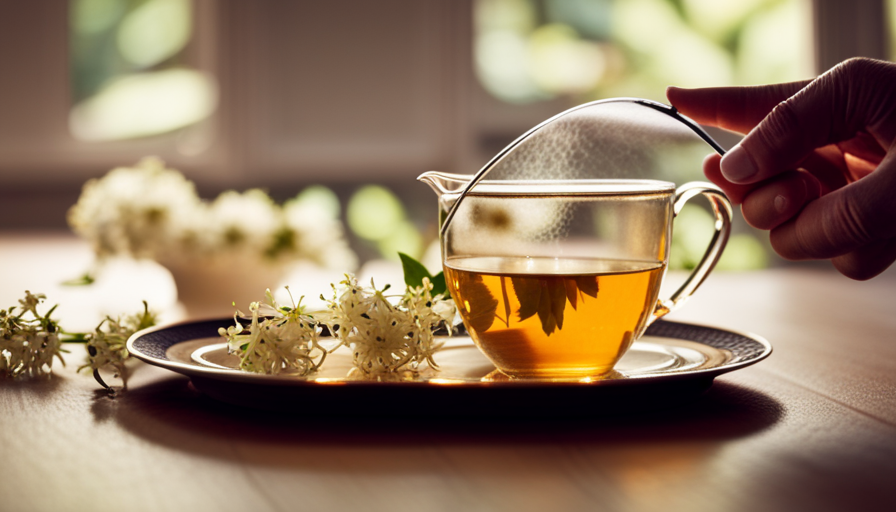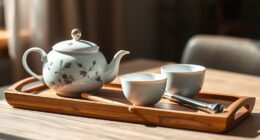You may be wondering, what is a tea olive flower? At first glance, it may seem like just a simple flower, but let me assure you, it is so much more.
Tea olive flowers, scientifically known as Osmanthus fragrans, are a botanical marvel with their unique characteristics and captivating fragrance.
Now, you might be thinking, why should I care about a flower? Well, let me tell you, tea olive flowers are not your average bloom. They possess an exquisite appearance, with small, white petals that cluster together to form a delicate and elegant blossom. But it’s not just their beauty that sets them apart; it’s their fragrance.
Tea olive flowers emit a heavenly aroma that is both sweet and floral, making them highly sought after in the perfume industry.
In this article, I will delve into the description and appearance of tea olive flowers, explore their seasonal blooming and lifespan, provide tips on their cultivation and care, discuss their symbolism and cultural significance, and even delve into creative uses and arrangements.
So, join me as we unravel the secrets of the captivating tea olive flower.
Key Takeaways
- Tea olive flowers are known for their unique characteristics and captivating fragrance.
- They attract pollinators like bees and butterflies and undergo pollination to develop into small fruits containing seeds.
- Tea olive flowers have medicinal properties and are used in traditional Chinese medicine.
- They hold cultural significance in Chinese and Japanese cultures and have inspired artists throughout history.
Introduction to Tea Olive Flowers
Imagine walking through a beautiful garden filled with tea olive flowers, their delicate petals releasing a sweet and enchanting fragrance. Tea olive flowers come in a variety of colors, including creamy white, yellow, and orange. These vibrant hues attract pollinators such as bees and butterflies, which play a crucial role in the reproduction of these flowers. The pollination process occurs when these insects collect nectar from the tea olive flowers and inadvertently transfer pollen from one flower to another. This process ensures the fertilization of the flowers and the production of seeds.
Moving on to the description and appearance of tea olive flowers, it’s fascinating to observe their unique structure and intricate patterns.
Description and Appearance of Tea Olive Flowers
Visualize a delicate, fragrant blossom resembling a tiny starburst, captivating your senses with its enchanting beauty. Tea olive flowers, scientifically known as Osmanthus fragrans, are small, cream-colored blooms that grow in clusters.
Each flower consists of four petals, arranged in a symmetrical pattern, and emits a sweet, intoxicating fragrance. These flowers possess unique medicinal properties, including anti-inflammatory and anti-bacterial effects. They’ve been used in traditional medicine for treating respiratory ailments and promoting digestion.
Tea olive flowers undergo pollination through the help of insects, such as bees and butterflies, which transfer pollen from the male to the female flowers. Once pollinated, the flowers develop into small, fleshy fruits containing seeds. This intricate process ensures the reproduction of tea olive plants.
Transitioning to the subsequent section, the fragrance and aroma of tea olive flowers are as captivating as their appearance.
Fragrance and Aroma of Tea Olive Flowers
Breathe in deeply and let the enchanting fragrance of these delicate blossoms transport you to a world of sweet, intoxicating scents that captivate your senses. The tea olive flower, scientifically known as Osmanthus fragrans, releases a heavenly aroma that has been treasured for centuries.
Not only does it bring pleasure to the senses, but it also offers numerous benefits. The tea olive flower is commonly used in traditional Chinese medicine for its anti-inflammatory properties and its ability to promote relaxation and calmness. Additionally, the flower is highly sought after for its essential oil, which is extracted through a meticulous process. This oil is renowned for its therapeutic properties, including relieving stress, improving sleep, and enhancing mood.
As we delve further into the seasonal blooming and lifespan of tea olive flowers, we will explore the wonders of this captivating plant.
Seasonal Blooming and Lifespan of Tea Olive Flowers
Get ready to be transported to a world of captivating scents as you witness the tea olive flowers blooming and flourishing like a colorful symphony in the breeze. The seasonal blooming of tea olive flowers is a sight to behold, with their delicate white petals and vibrant yellow centers. These flowers typically bloom in the fall and winter seasons, adding a touch of elegance to the landscape during cooler months. The lifespan of tea olive flowers is relatively short, lasting only a few weeks before they wither away. However, their fragrance and beauty leave a lasting impression. Tea olive flowers hold a symbolic meaning of peace, love, and purity, making them a popular choice for wedding bouquets and floral arrangements. For successful cultivation, it is important to provide well-drained soil, full sunlight, and regular watering. These tips will ensure a healthy and vibrant display of tea olive flowers in your garden. Now, let’s delve into the cultivation and care of tea olive flowers.
Cultivation and Care of Tea Olive Flowers
Prepare your garden by selecting a sunny spot with well-drained soil and providing regular watering to cultivate and care for these delicate and vibrant blooms. Tea olive flowers require proper pruning techniques to maintain their shape and promote healthy growth. Prune in early spring to remove dead or damaged branches, and shape the plant by selectively trimming branches for a more compact form.
Regular pest control measures are necessary to protect tea olive flowers from common pests such as aphids and scale insects. Monitor the plant regularly and use appropriate insecticides or natural remedies as needed. With diligent care, your tea olive flowers will thrive and provide a beautiful addition to your garden.
Transitioning to the next topic, tea olive flowers hold great symbolism and cultural significance in many societies.
Symbolism and Cultural Significance of Tea Olive Flowers
Embrace the rich cultural history of tea olive flowers and discover the profound symbolism they hold in various societies. The tea olive flower, also known as Osmanthus fragrans, is not only admired for its intoxicating fragrance, but also for its symbolic meaning in art and traditional ceremonies. In Chinese culture, tea olive flowers represent good luck and prosperity, often used in weddings and Chinese New Year celebrations. In Japanese culture, they symbolize purity and are commonly incorporated in tea ceremonies. These delicate flowers have inspired countless artists throughout history, appearing in paintings, poetry, and even pottery. Their elegant beauty and captivating aroma make them a popular choice for creative arrangements and bouquets. Transitioning into the subsequent section about ‘creative uses and arrangements with tea olive flowers,’ they offer endless possibilities for adding a touch of natural elegance to any occasion.
Creative Uses and Arrangements with Tea Olive Flowers
Enhance your surroundings with the exquisite beauty and enchanting fragrance of these delicate blooms, as they effortlessly grace any space with their natural elegance and timeless allure.
Tea olive flower arrangements offer a creative way to showcase the unique charm of these blossoms. Whether used as a standalone centerpiece or incorporated into a larger floral arrangement, tea olive flowers add a touch of sophistication and refinement.
Their small, white petals and vibrant aroma make them perfect for DIY tea olive crafts such as wreaths, potpourri, or even scented candles. By carefully arranging these blooms, you can create stunning displays that capture the essence of nature’s beauty.
Let your creativity flourish as you explore the endless possibilities of tea olive flower arrangements and crafts.
Frequently Asked Questions
Are tea olive flowers edible, and can they be used in cooking or brewing tea?
Tea olive flowers are not typically consumed, but they can be used to infuse flavor in cooking and tea. Their health benefits include antioxidant properties and potential anti-inflammatory effects. In culinary arts, tea olive flowers can add a unique floral fragrance to dishes and beverages.
What are the different colors of tea olive flowers, and do they vary in fragrance based on their color?
Do tea olive flowers vary in color and fragrance? How do they compare to other fragrant flowers? Different varieties of tea olive flowers come in various colors and emit a delightful fragrance, often comparable to other fragrant flowers.
Can tea olive flowers survive in colder climates, or are they limited to specific regions?
Tea olive flowers can thrive in colder climates with proper cultivation techniques. However, lower temperatures may affect their fragrance and bloom longevity. Understanding temperature impacts on tea olive flowers is crucial for successful cultivation in colder regions.
Are there any potential pests or diseases that commonly affect tea olive flowers?
There are several potential pests and common diseases that can affect tea olive flowers. Some common pests include aphids, scales, and spider mites, while diseases such as powdery mildew and leaf spot can also be problematic.
Are there any specific pruning techniques or care instructions for maintaining healthy and abundant tea olive flower growth?
To maintain healthy and abundant tea olive flower growth, proper pruning techniques and care instructions are essential. Prune in early spring before new growth appears, removing dead or diseased branches. Provide well-draining soil, regular watering, and apply a balanced fertilizer to promote vigorous flower production.
Conclusion
In conclusion, the tea olive flower is a beautiful and fragrant addition to any garden or floral arrangement. Its delicate appearance and intoxicating aroma make it a favorite among flower enthusiasts. With proper care and cultivation, tea olive flowers can bloom throughout the year, adding beauty and elegance to any space.
Whether used for their symbolic meaning or simply for their aesthetic appeal, tea olive flowers are a versatile and cherished flower. As the saying goes, "A garden without flowers is like a painting without color."
"A garden without flowers is like a painting without color, lacking the vibrancy and joy that only nature’s blooms can bring."










